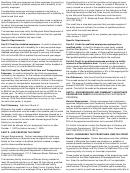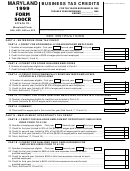Instructions For Maryland Form 500cr - Business Tax Credits - 1999
ADVERTISEMENT
INSTRUCTIONS FOR
MARYLAND FORM 500CR
BUSINESS TAX CREDITS
1999
GENERAL INSTRUCTIONS
4. were hired by the business after the later of the date on
which the enterprise zone was designated or the date on
Purpose of Form. Form 500CR is used to claim business tax
which the business entity located in the enterprise zone.
credits against corporation or personal income tax.
In addition, an employee may not have been hired to replace an
The tax credits available to be reported on this form are the
individual employed by the business in that or the three previous
Enterprise Zone Tax Credit, the Employment Opportunity Tax
taxable years except an economically disadvantaged employee
Credit*, the Employment of Individuals with Disabilities Tax
hired to replace a previously qualified economically disadvan-
Credit*, the Job Creation Tax Credit, the Neighborhood and
taged employee, for whom the business received the corre-
Community Assistance Program Tax Credit, the Businesses
sponding first- or second-year credit in the immediately preced-
that Create New Jobs Tax Credit, the Heritage Area Tax
ing taxable year.
Credit, the Water Quality Improvement Credit, the Employer
Provided Long-Term Care Insurance Credit, the Work-Based
Economically disadvantaged employees are those who are
Learning Program Credit, the Clean-Fuel Vehicle Tax Credit
certified as such by the Maryland Department of Labor, Licens-
and the Telecommunications Property Tax Credit.
ing and Regulation, Division of Employment and Training, 1100
N. Eutaw Street, Baltimore, MD 21201 (410-767-2047). That
*Tax-exempt organizations. For application of these credits against
office will provide information relating to certification require-
employer withholding tax, see Administrative Release No. 34.
ments for such employees.
Pass-through entities. Each individual partner, shareholder or
Specific Requirements
member’s apportioned share of each business tax credit must be
itemized on the K-1 provided to that partner, shareholder or member.
Complete Part A-I and A-II if you are located in an enterprise
zone but not in a focus area. Complete Part A-III and A-IV if you
Name and Other Information. Type or print the name as shown
are located in a focus area.
on Form 500, Form 502, Form 505 or Form 510 in the desig-
nated area. Enter the taxpayer identification number (Social
Part A-I Credit for economically disadvantaged employees. A
Security number or federal identification number). If a federal
credit is allowed for each new economically disadvantaged
employer identification number (FEIN) is to be used and has not
employee for a three-year period beginning with the year the
been secured, enter “APPLIED FOR” followed by the date of
employee was qualified. The credits are limited to the following
application. If you have not applied for a FEIN, please do so
amounts of wages paid to the same economically disadvantaged
immediately.
employee: $1,500 in the first year, $1,000 in the second year and
$500 in the third year. If the employee replaced a previously
Taxable Year or Period. Enter the beginning and ending dates
qualified economically disadvantaged employee, the credit for the
in the space provided at the top of Form 500CR. The form used
new employee will be the same as would have been allowed for
for filing must reflect the same tax year as the annual tax return.
the replaced employee.
When and Where to File. Form 500CR must be attached to the
Part A-II Credit for other qualified employees. A credit is
annual return (Form 500, 502, 505 or 510) and filed with the
allowed for each new qualified employee not provided in Part A-
Comptroller of the Treasury, Revenue Administration Division,
I. The credit is limited to $500 of wages paid and is applicable for
Annapolis, Maryland 21411-0001.
only the first year the employee was qualified.
PART A - ENTERPRISE ZONE TAX CREDIT
Part A-III Credit for economically disadvantaged employees
located in a focus area. A credit is allowed for each new
General Requirements. Businesses located in an enterprise
economically disadvantaged employee for a three-year period
zone may be eligible for tax credits based upon wages paid to
beginning with the year the employee was qualified. The credits
qualifying employees. For information on the location of enter-
are limited to the following amounts of wages paid to the same
prise zones and the standards which businesses must meet to
economically disadvantaged employee: $3,000 in the first year,
qualify, contact the Maryland Department of Business and
$2,000 in the second year and $1,000 in the third year. If the
Economic Development, Office of Research, 217 E. Redwood
employee replaced a previously qualified economically disad-
Street, Baltimore, MD 21202 (410-767-6438).
vantaged employee, the credit for the new employee will be the
Businesses owning, operating, developing, constructing or
same as would have been allowed for the replaced employee.
rehabilitating property intended for use primarily as single-or
Part A-IV Credit for other qualified employees located in a
multi-family residential property are not eligible for the enterprise
focus area. A credit is allowed for each new qualified employee
zone tax credit.
not provided in Part A-III. The credit is limited to $1,000 of
Qualifying employees are those employees who:
wages paid and is applicable for only the first year the employee
was qualified.
1. are new employees or employees rehired after being laid
off for more than one year;
Part A-Summary. Add lines 5,7,12 and 14 and enter total.
2. were employed at least 25 hours per week by the busi-
Whenever an Enterprise Zone Tax Credit is claimed against the
ness for at least six months before or during the business
income tax, an addition modification must be made in the
entity’s taxable year for which a credit is claimed;
taxable year for which the wages claimed as a credit were paid.
The modification increases the taxable income base to the
3. spent at least one-half of their working hours in the
extent of the total credit claimed against the tax liability for the
enterprise zone on activities of the business resulting
taxable year.
directly from its location in the enterprise zone; and
ADVERTISEMENT
0 votes
Related Articles
Related forms
Related Categories
Parent category: Financial
 1
1 2
2 3
3 4
4








